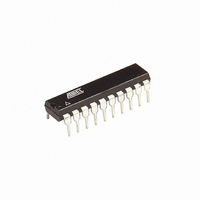ATTINY26-16PJ Atmel, ATTINY26-16PJ Datasheet - Page 86

ATTINY26-16PJ
Manufacturer Part Number
ATTINY26-16PJ
Description
ID MCU AVR 2K 5V 16MHZ 20-DIP
Manufacturer
Atmel
Series
AVR® ATtinyr
Specifications of ATTINY26-16PJ
Core Processor
AVR
Core Size
8-Bit
Speed
16MHz
Connectivity
USI
Peripherals
Brown-out Detect/Reset, POR, PWM, WDT
Number Of I /o
16
Program Memory Size
2KB (1K x 16)
Program Memory Type
FLASH
Eeprom Size
128 x 8
Ram Size
128 x 8
Voltage - Supply (vcc/vdd)
4.5 V ~ 5.5 V
Data Converters
A/D 11x10b
Oscillator Type
Internal
Operating Temperature
-40°C ~ 85°C
Package / Case
20-DIP (0.300", 7.62mm)
Lead Free Status / RoHS Status
Lead free / RoHS Compliant
- Current page: 86 of 182
- Download datasheet (3Mb)
SPI Master Operation
Example
86
ATtiny26(L)
ples data at negative and changes the output at positive edges. The USI clock modes
corresponds to the SPI data mode 0 and 1.
Referring to the timing diagram (Figure 46.), a bus transfer involves the following steps:
1. The slave device and master device sets up its data output and, depending on the proto-
2. The master generates a clock pulse by software toggling the SCK line twice (C and D).
3. Step 2. is repeated eight times for a comlpete register (byte) transfer.
4. After eight clock pulses (i.e., 16 clock edges) the counter will overflow and indicate that
The following code demonstrates how to use the USI module as a SPI master:
The code is size optimized using only 8 instructions (+ ret). The code example assumes that the
DO and SCK pins are enabled as output in the DDRB Register. The value stored in register r16
prior to the function is called is transferred to the slave device, and when the transfer is com-
pleted the data received from the slave is stored back into the r16 register.
The second and third instructions clears the USI Counter Overflow Flag and the USI counter
value. The fourth and fifth instruction set Three-wire mode, positive edge Shift Register clock,
count at USITC strobe, and toggle SCK (PORTB2). The loop is repeated 16 times.
col used, enables its output driver (mark A and B). The output is set up by writing the
data to be transmitted to the serial Data Register. Enabling of the output is done by set-
ting the corresponding bit in the port data direction register (DDRB2). Note that point A
and B does not have any specific order, but both must be at least one half SCK cycle
before point C where the data is sampled. This must be done to ensure that the data
setup requirement is satisfied. The 4-bit counter is reset to zero.
The bit value on the slave and master’s data input (DI) pin is sampled by the USI on the
first edge (C), and the data output is changed on the opposite edge (D). The 4-bit counter
will count both edges.
the transfer is completed. The data bytes transferred must now be processed before a
new transfer can be initiated. The overflow interrupt will wake up the processor if it is set
to Idle mode. Depending of the protocol used the slave device can now set its output to
high impedance.
SPITransfer:
SPITransfer_loop:
out
ldi
out
ldi
out
sbis
rjmp
in
ret
USIDR,r16
r16,(1<<USIOIF)
USISR,r16
r16,(1<<USIWM0)+(1<<USICS1)+(1<<USICLK)+(1<<USITC)
USICR,r16
USISR,USIOIF
SPITransfer_loop
r16,USIDR
1477K–AVR–08/10
Related parts for ATTINY26-16PJ
Image
Part Number
Description
Manufacturer
Datasheet
Request
R

Part Number:
Description:
Manufacturer:
Atmel Corporation
Datasheet:

Part Number:
Description:
IC AVR MCU 2K 16MHZ IND 32-QFN
Manufacturer:
Atmel
Datasheet:

Part Number:
Description:
IC AVR MCU 2K 16MHZ IND 20-SOIC
Manufacturer:
Atmel
Datasheet:

Part Number:
Description:
IC AVR MCU 2K 16MHZ IND 20-DIP
Manufacturer:
Atmel
Datasheet:

Part Number:
Description:
IC AVR MCU 2K 16MHZ IND 32-QFN
Manufacturer:
Atmel
Datasheet:

Part Number:
Description:
IC AVR MCU 2K 16MHZ IND 20-DIP
Manufacturer:
Atmel
Datasheet:

Part Number:
Description:
IC AVR MCU 2K 16MHZ COM 20-SOIC
Manufacturer:
Atmel
Datasheet:

Part Number:
Description:
IC AVR MCU 2K 16MHZ IND 20-SOIC
Manufacturer:
Atmel
Datasheet:

Part Number:
Description:
ID MCU AVR 2K 5V 16MHZ 32-QFN
Manufacturer:
Atmel
Datasheet:

Part Number:
Description:
Microcontrollers (MCU) AVR 2K FLASH 128B EE 128B SRAM ADC
Manufacturer:
Atmel
Datasheet:

Part Number:
Description:
IC AVR MCU 2K 16MHZ COM 32-QFN
Manufacturer:
Atmel
Datasheet:

Part Number:
Description:
IC AVR MCU 2K 16MHZ COM 20-DIP
Manufacturer:
Atmel
Datasheet:

Part Number:
Description:
ID MCU AVR 2K 5V 16MHZ 20-SOIC
Manufacturer:
Atmel
Datasheet:

Part Number:
Description:
IC MCU AVR 2K 16MHZ IND 20SOIC
Manufacturer:
Atmel
Datasheet:










